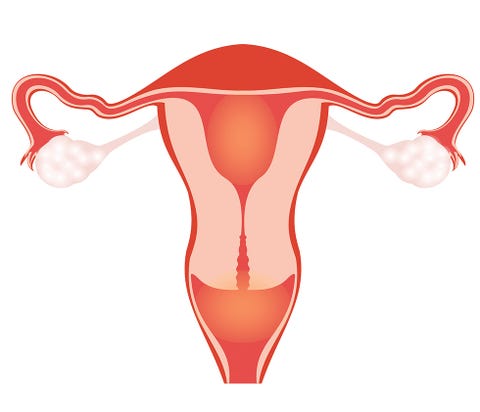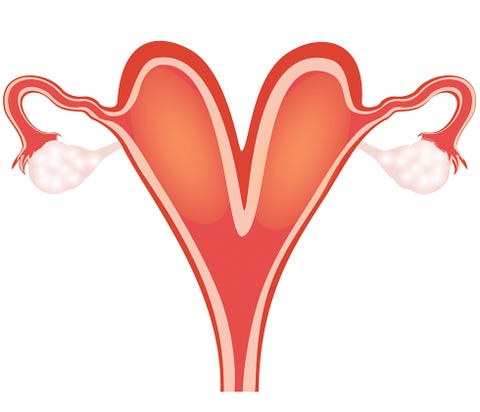
You’re likely not terribly well acquainted with your uterus—unless, you know, you’re growing a baby inside of it right now—but if you hear yours is shaped like a heart, you might think, Damn, that sounds poetic as hell.
I mean, yeah, being able to tell people you have a heart-shaped uterus sounds like an awesome conversation starter. (No? Just me? Moving on…) But it’s not always a totally harmless thing and can be linked to various gynecological conditions like endometriosis or even recurrent miscarriages.
So let’s say your ob-gyn mentioned that you do, in fact, have a heart-shaped uterus. Here’s what you need to know.
Um, what’s the difference between a heart-shaped uterus and a typical one?

Your uterus—a.k.a., that muscular organ in your abdomen that holds and nourishes a growing baby—typically looks like like an inverted pear with horns (actually your fallopian tubes) attached at widest part of the “fruit” at the top.
The baby actually develops inside the uterus’s fundus—the largest, hollowed-out portion of the organ, says David F, Colombo, M.D., an ob-gyn and the division chief of maternal fetal medicine at Spectrum Health Medical Group in Grand Rapids, Mich.
But with a heart-shaped uterus—a.k.a., a bicornate uterus—that shape looks more like, well, a heart, says Colombo. “You still have the main uterine cavity, but the two tubes come together and leave a little indent at the top,” he says.
So what causes a heart-shaped uterus?

A heart-shaped uterus is actually a type of congenital uterine anomaly, meaning, if you have one, your uterus developed abnormally while you were still in the womb, says Megan Cheney, M.D., an ob-gyn and the medical director at Banner University Women’s Clinic in Phoenix, Arizona.
And while uterine anomalies in general aren’t terribly common—only 3 to 6 percent of women have them—bicornuate uteri are most likely, with 26 percent of uterine abnormalities being heart-shaped.
One thing to note, though: Though heart-shaped uteri are congenital, they’re not genetic. So the shape of your uterus might be totally different than your mom’s.
Is having a heart-shaped uterus a bad thing?
Honestly, it depends. Many women go their whole lives without even knowing that they have a heart-shaped uterus. It’s asymptomatic, for one thing. And it has no effect on your periods; your menstrual cycle goes according to your regular plan.
In rarer cases, a heart-shape uterus may put you at a higher risk for endometriosis, which happens when the normal lining of the uterus sheds during your period and flows back through the fallopian tubes into your belly instead of your cervix, says Colombo. “Any time you have a uterine anomaly, there is an increased risk for retrograde menstrual flow.”

The biggest issue with a heart-shaped uterus, however, is the chance of recurrent miscarriages, preterm birth, possible breach babies (a.k.a., when the baby wants to come out bottom-first, instead of head-first) at term, or other pregnancy issues, says Colombo.
In fact, a 2011 study in the American Journal of Obstetrics and Gynecology found that the presence of any uterine anomaly (including a heart-shaped uterus) increased the risk of preterm delivery, breech deliveries, and necessary cesarean sections. And while it’s not known why these heart-shaped uteri cause pregnancy and delivery issues, it’s believed that the malformed uterus may hinder a fetus’s growth.
How will I know if I have a heart-shaped uterus—and what can I do about it?
“The only way to tell if you have one is to have a 3D ultrasound or MRI,” says Cheney. Usually what ends up happening is women get testing and/or imaging done if they have had recurrent miscarriages (typically after three of them), have experienced infertility, or have had a breech birth at term—again, all which may be caused by a heart-shaped uterus.

Another imaging study often used to detect a uterine malformation is a hysterosalpingogram. “It’s a procedure where dye is injected through the cervix, goes up through the tubes, and a special X-ray is performed which can show not only the shape of a uterus, but any tubal defects as well,” says Kecia Gaither, M.D., an ob-gyn and the director of perinatal services for NYC Health+Hospitals/Lincoln in New York City.
Once you find out that you do have a heart-shaped uterus, you may wonder if there’s a way to correct it—and if you even should.
If a woman has had frequent miscarriages, says Colombo, then the indent at the top of the “heart” can be removed with surgery (called a Jones procedure, specifically).
But it’s rare for women to opt for these surgeries, he adds—and most of the time, heart-shaped uterus or not, a pregnancy that’s closely monitored will be successful. “Most women with [a heart-shaped uterus] don’t even know they have it and, if we watch them carefully through the pregnancy, they do fine.”
Source: Read Full Article





